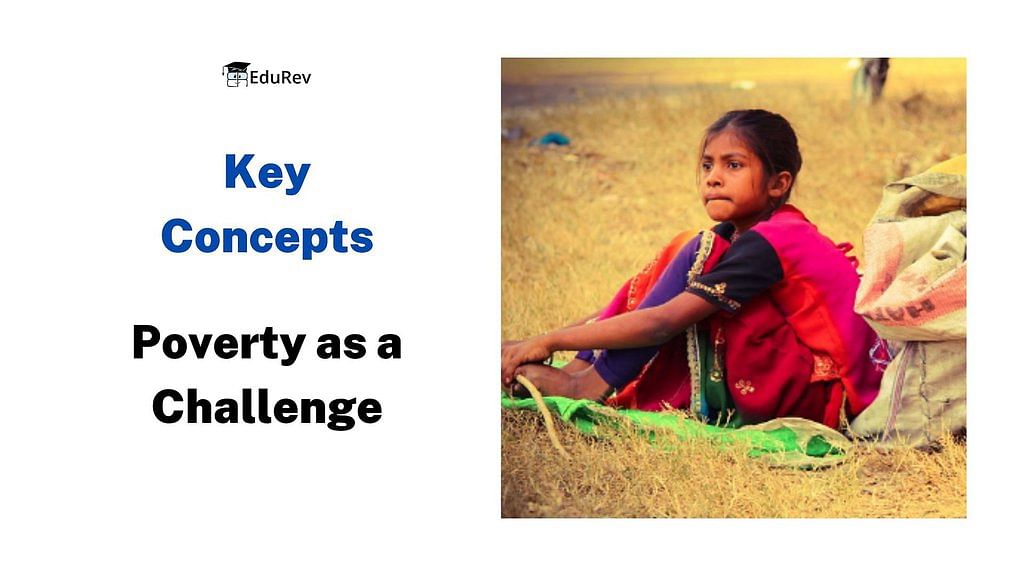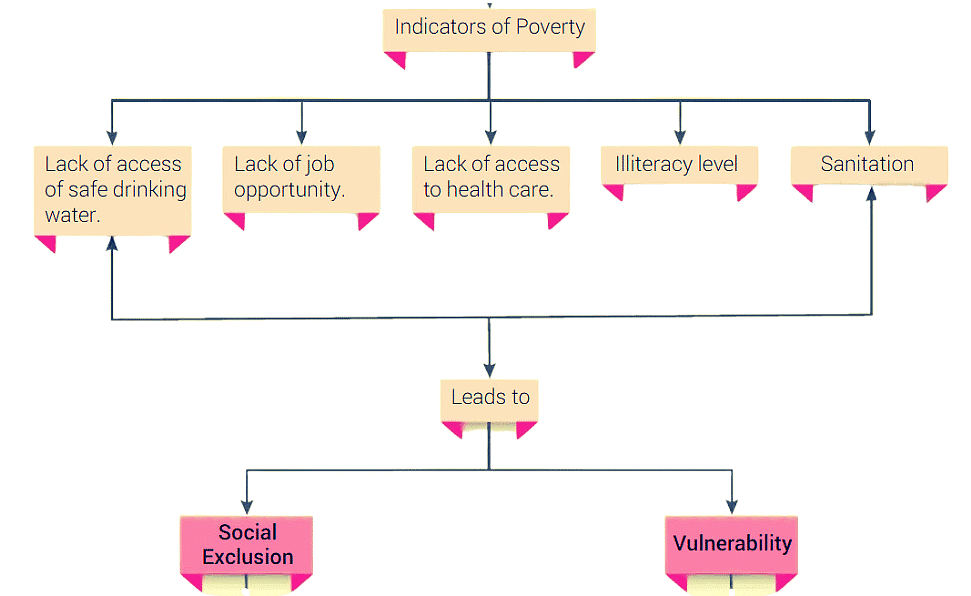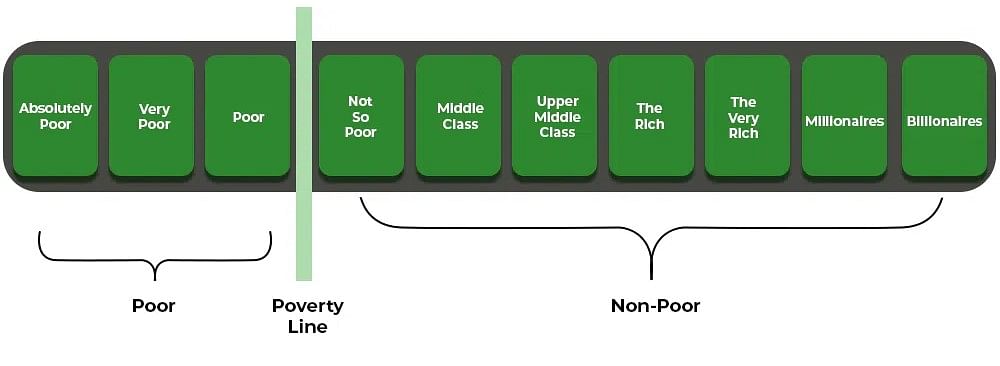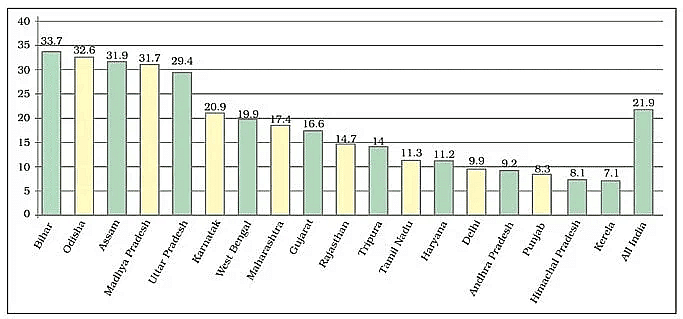Class 9 Exam > Class 9 Notes > Social Studies (SST) Class 9 > Key Concepts - Poverty as a Challenge
Key Concepts - Poverty as a Challenge | Social Studies (SST) Class 9 PDF Download
| Table of contents |

|
| Poverty |

|
| Poverty as seen by Social Scientists |

|
| Poverty Line |

|
| Inter-State Disparities |

|
| Global Poverty Scenario |

|
| Causes of Poverty |

|
| Anti Poverty Measures |

|
| The Challenges Ahead |

|
Poverty
- Poverty is a prevalent issue in daily life, visible in various forms such as landless laborers, overcrowded urban slums, daily wage workers, and child laborers.
- Every fourth person in India is considered poor.

Poverty as seen by Social Scientists
- Poverty is studied using various indicators, including income, consumption, illiteracy, malnutrition, healthcare access, job opportunities, and essential amenities.
- Social scientists now analyze poverty through the lens of social exclusion, a process where individuals or groups are deprived of facilities, benefits, and opportunities, extending beyond income levels.

- Vulnerability to poverty measures the increased likelihood of certain communities or individuals, like those from backward castes or widows, becoming or remaining poor.
- This includes assessing options for alternative living and increased risks during natural disasters, terrorism, or economic challenges.
- The social and economic capacity of groups to handle risks associated with natural disasters, terrorism, or economic downturns is analyzed as part of vulnerability assessment.
- Poverty, viewed through social exclusion, is not solely about low income but involves individuals being confined to impoverished surroundings, excluded from the social equality enjoyed in more prosperous environments.
Question for Key Concepts - Poverty as a ChallengeTry yourself: What is the concept of poverty analyzed by social scientists?View Solution
Vulnerability
- Vulnerability describes the greater probability of being more adversely affected than other people, which is due to an earthquake or simply a fall in the availability of jobs.
- Measurement of vulnerability to poverty describes the greater probability of certain communities.
i.e., members of a backward caste, or individuals like a widow or a physically handicapped person.
Poverty Line
The poverty line is a way that is used to identify the poor. It is a method used to measure poverty.
 Poverty Line Explanation
Poverty Line Explanation
- The poverty line is determined by factors such as food, clothing, footwear, education, medical needs, etc.
- In India, it is calculated based on the calorie requirement, with variations in rural and urban areas.
Poverty Estimates
- The key concepts emphasize a notable decline in poverty ratios in India, decreasing from about 45% in 1993-94 to 37.2% in 2004–05.
- The proportion of people below the poverty line further dropped to around 22% in 2011–12, with a potential future reduction to less than 20%.
- Despite a percentage decline in poverty from 1973–1993, the actual number of poor individuals significantly decreased from 407 million in 2004–05 to 270 million in 2011–12, reflecting an average annual decline of 2.2 percentage points from 2004–05 to 2011–12.
Inter-State Disparities
- Poverty rates vary across Indian states, with Bihar and Odisha having high poverty ratios.
- Regional strategies, land reforms, and public distribution influence poverty reduction.
 Graph Depicting Inter-State Disparities
Graph Depicting Inter-State Disparities
- Orissa and Bihar are the poorest states of India with poverty ratios of 47 percent and 43 percent, respectively.
- The lowest incidence of poverty is found in Jammu and Kashmir with a poverty ratio of just 3.5 percent.
Question for Key Concepts - Poverty as a ChallengeTry yourself: What is vulnerability?View Solution
Global Poverty Scenario
- Global poverty rates: Decreased from 16.27% in 2010 to 9.05% in 2019.
- Substantial differences in poverty reduction across regions.
- China and Southeast Asian countries benefited from rapid economic growth and investments in human resource development.
- Poverty in China dropped from 2.1% in 2014 to 0.1% in 2020.
- Rapid decline in poverty from 34% in 2005 to 15.2% in 2014.
- Significant reduction, e.g., from 510.4 million in 2005 to 274.5 million in 2013 in South Asia.
- Sub-Saharan Africa saw a decrease from 36.6% in 2017 to 35.4% in 2019, while Latin America increased from 4.4% in 2017 to 4.6% in 2019.
- Some former socialist countries, like Russia, experienced the reappearance of poverty.
- UN Sustainable Development Goals: Aim to eradicate all types of poverty globally by 2030.
Causes of Poverty
- Historical factors under British rule, low economic development, and unequal distribution of resources.
- Land scarcity, income inequalities, and challenges faced by small farmers contribute to poverty.

- Our agricultural sector has failed to generate many employment opportunities for farm laborers. Similarly, our industries could not provide many jobs for job seekers.
- One of the major causes of poverty is the unequal distribution of land and other resources. Various land reform measures introduced after Independence could not improve the lives of millions of rural poor because of their poor implementation.
- Social factors: People in India, including the very poor, spend a lot of money on social occasions like marriages, festivals, etc.
- Poor people hardly have any savings; they are, thus forced to borrow. Unable to pay because of poverty, they became victims of indebtedness.
Anti Poverty Measures
- Our government’s strategy for poverty reduction has been two fold.
(i) Promotion of economic growth.
(ii) Targeted poverty alleviation programs.
- Two-fold strategy: promotion of economic growth and targeted anti-poverty programs.
- Notable schemes include Mahatma Gandhi National Rural Employment Guarantee Act, Prime Minister Rozgar Yojana, Rural Employment Generation Programme, Swarnajayanti Gram Swarozgar Yojana, and Pradhan Mantri Gramodaya Yojana.
The Challenges Ahead
- Though poverty has declined in India, poverty reduction remains India’s most compelling challenge.
- We will have to do something special to fight against wide regional disparities.
- We must broaden the definition of poverty from a minimum subsistence level of living to a reasonable level of living.
- Bigger challenges before us are providing health care, education, and job security for all the achieving gender equality.
Question for Key Concepts - Poverty as a ChallengeTry yourself: What is the poverty line based on in India?View Solution
The document Key Concepts - Poverty as a Challenge | Social Studies (SST) Class 9 is a part of the Class 9 Course Social Studies (SST) Class 9.
All you need of Class 9 at this link: Class 9
|
52 videos|437 docs|80 tests
|
FAQs on Key Concepts - Poverty as a Challenge - Social Studies (SST) Class 9
| 1. What is the poverty line, and how is it determined? |  |
Ans. The poverty line is a threshold that determines the minimum income level necessary for individuals or families to meet their basic needs, such as food, clothing, and shelter. It is typically established by governments or organizations based on various factors like the cost of living, inflation, and consumption patterns. In many countries, the poverty line is adjusted periodically to reflect changes in these economic conditions.
| 2. What are the main causes of poverty? |  |
Ans. The main causes of poverty include lack of education, unemployment, discrimination, lack of access to healthcare, and economic instability. Other contributing factors can be natural disasters, political instability, and social inequality. Understanding these causes helps in formulating effective anti-poverty measures.
| 3. How do inter-state disparities affect poverty levels in a country? |  |
Ans. Inter-state disparities refer to the differences in economic development, resources, and living standards among various states within a country. These disparities can lead to unequal access to opportunities, resulting in higher poverty levels in less developed states. Such inequalities may hinder overall national growth and require targeted policies to address regional imbalances.
| 4. What are some effective anti-poverty measures implemented globally? |  |
Ans. Some effective anti-poverty measures include social welfare programs, microfinance initiatives, job creation schemes, education and vocational training, and health care access improvements. Governments and NGOs often collaborate on these initiatives to empower individuals and communities, providing them with the means to achieve sustainable livelihoods.
| 5. What challenges do countries face in addressing poverty? |  |
Ans. Countries face several challenges in addressing poverty, including limited financial resources, political instability, corruption, inadequate infrastructure, and socio-cultural barriers. Additionally, global issues such as climate change and economic fluctuations can exacerbate poverty, making it difficult for nations to implement effective solutions consistently.

|
Explore Courses for Class 9 exam
|

|
Signup for Free!
Signup to see your scores go up within 7 days! Learn & Practice with 1000+ FREE Notes, Videos & Tests.
Related Searches


















